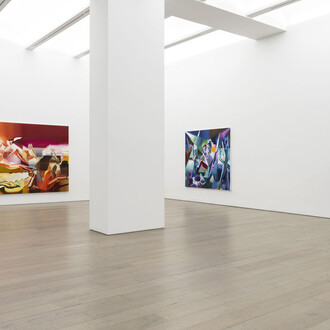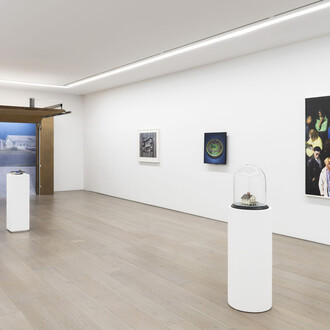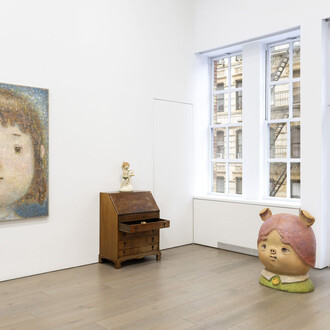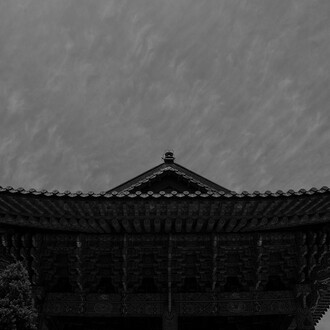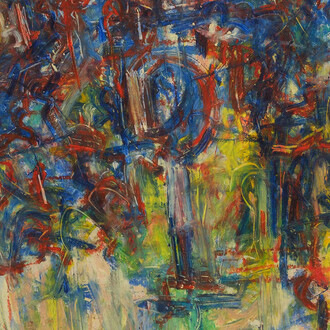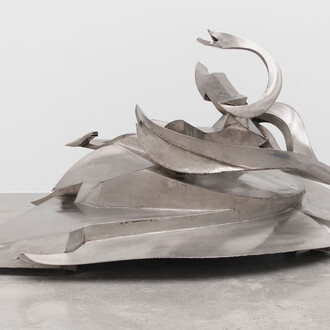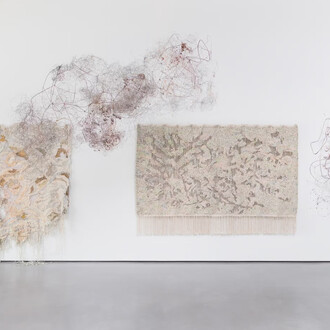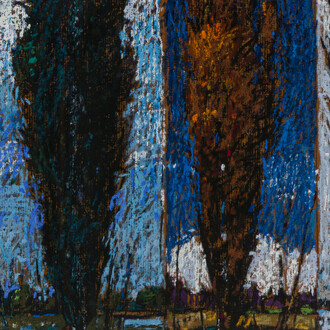Perrotin New York is pleased to present Guadalajara-based artist Gabriel Rico’s solo exhibition, titled A finger pointing to the moon. Characterized by the interrelation of seemingly disparate objects, Rico reflects on the relationship between humans and our environment. His installations integrate irony and poetry through the combination of natural and man-made forms, prompting an awareness of their asymmetry to reveal cultural and political flaws. Through object-making, assemblage-based installations, and a keen understanding of material processes, Rico achieves a precise geometry from his carefully chosen objects.
Several works in the exhibition are architecturally contingent, if not site-specific, hinging on structural elements within the gallery. Take, for example, Arquitectura (Ceramic sausage), a sausage that is comically positioned on one of the gallery’s columns as a meditation on our dependence on the built environment. A cartoonish stand-in for human presence, each Arquitectura signifies what it means to be bound, or hamstrung, to a particular site and its infrastructure. Each sausage figure is personified in its depiction, in different physical positions, held captive in the gallery. This conflation of human and non-human experience is integral to Rico’s notion of a heuristic ontology, in which human-centered ideas can be recalibrated to emphasize each object’s precarious status. Suspended in the center of the gallery is Nearness, a monumental sculpture that depicts two skeletal figures in an embrace, both covered in glass sausages. The skeletons hang from interlocking chains that symbolize a love that upholds body and spirit. The individual hotdog forms playfully punctuate the bones of the skeletons, animating these figures whose fragility resides in the liminal spaces between life and death, the archaeological and the contemporary.
On the surrounding gallery walls, Rico’s Fat geometry series depicts abstract images of bodily contours that continue his exploration into the human figure. These textile surfaces speak to the tactility of the skin as a container. Each canvas represents a slice, or layer, of the figure that reveals the commonalities between bodies—breasts, knuckles, chest, buttocks, decolletage, neck, or backside— regardless of gender, culture, or other indicators of identity. Using the geometry of the canvas as a framework, these artworks read as paintings, but upon closer inspection reveal a surface of cotton yarn on wooden boards coated with beeswax. Works from this series are created using an Indigenous embroidery method, called Nierika, which originated in the Huichole community to translate their visions into ritual artifacts. In Rico’s use of this method, he transforms his own postulations into two-dimensional images pressed in yarn.
Similarly, Decorative permutations I and II, also made with the Nierika yarn technique, appear from a distance to have beveled, mirrored surfaces, producing a sheen that implies an altogether different type of manufacture. Each work consists of a winding tree branch, representing the trajectory of humanity, dotted by yellow, orange, and green fruits which bear ancient and contemporary symbols.
In Made to the measure of the world (The stick is the surest peacemaker) I and II, Rico lays out a diagram in which we might begin to make sense of the everyday. Each work maps out a sequence of symbols that telegraph different messages subject to an individual viewer’s worldview. From a certain distance, the distinction between found object—shells or a comb—and artistic rendering—fishing bait or a chili pepper—is difficult to detect, offering another layer of discovery. Arranged like an archeological reliquary, or a simple architectural floor plan, Made to the Measure of the World suggests that human (and perhaps non-human) experience is determined as much by the meaning we assign to an object as the conditions of the place where a signifier is situated. The second part of the title, The stick is the surest peacemaker, refers to the potential effects of the technologies incorporated into the two works. Are any of these objects appropriate tools of diplomacy? Only in the totality of an artwork like Rico’s can such objects function as a peace offering.
Similar in its variety of source material, A technology of correspondence III blurs the linear framework conveyed in Made to the Measure into something closer to an associative flowchart. To this arrangement, a process of classification inevitably unfolds. Rico incorporates feathers and tree branches, while other referents are simulacra, like glass bones and gilded twigs. An additional layer of complexity comes across in the selection of objects that take on symbolic qualities much like the indivisibility of a prime number. Critical to these assemblage-based installations are how they can be read sequentially, with their particular arrangements functioning as a mnemonic device that adds subjective meaning to our perception.
Finally, the components of Rico’s central sculpture Human prayer provide a tabula rasa for viewers to project their aspirations. Working with a totem of stones sourced from the Mexican landscape, Human prayer is scaled to the height of a human figure, magically upheld by golden arrows from every direction. While these arrows are fabricated tools, stones are a primal material extracted from the earth, foundational in constructing the built environment. The artist’s yearning for both a shared history and a collective imagination imbues his recent work with a sense of openness, inviting viewers to project their own experiences and reflect on their relationship to people, ideas, and objects.
(Sara Reisman)






